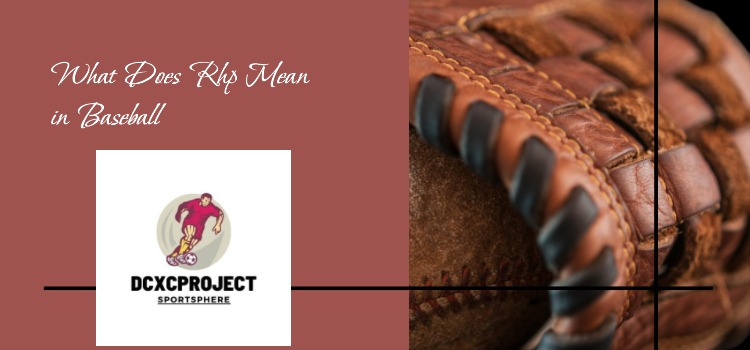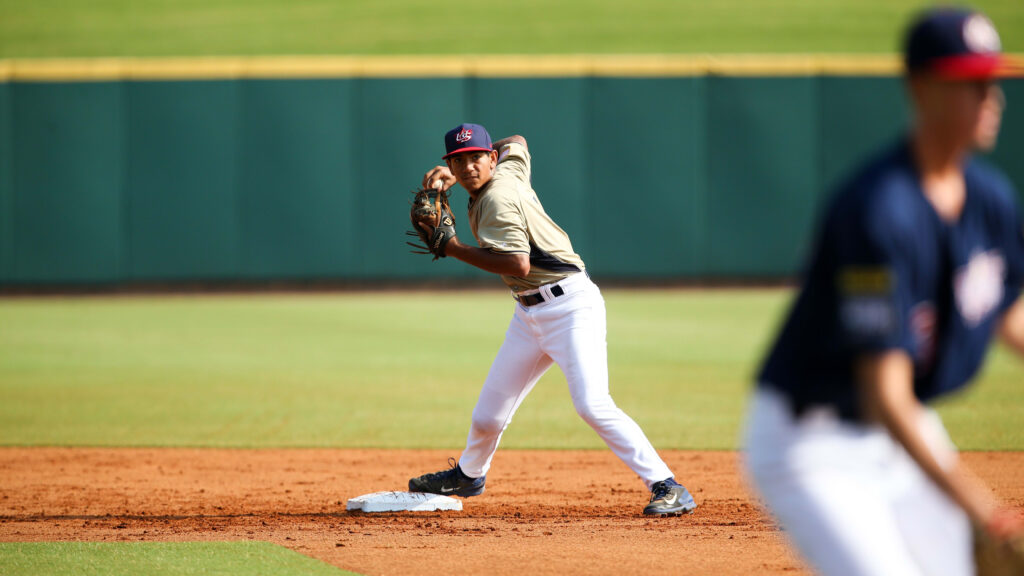RHP in baseball stands for Right-Handed Pitcher. This term describes a pitcher who throws the ball with their right hand.
Baseball, a sport rich in statistics and specialized positions, uses various abbreviations to streamline communication and analysis. A Right-Handed Pitcher (RHP) plays a fundamental role within any baseball team’s pitching staff, predominantly throwing the ball to batters using their right arm.
Understanding the term RHP is crucial for fans and players alike as it affects game strategy and player matchups. With pitching being a central element of the sport, knowing the handedness of a pitcher helps in predicting pitch types and patterns, thus enhancing the viewer’s comprehension of the game’s intricacies. RHPs make up a significant portion of a team’s rotation and bullpen, often tailored to face right-handed batters with different strategies compared to their left-handed counterparts (LHP).
Decoding Rhp In Baseball Language
The lexicon of baseball is rich with acronyms and jargon that can bewilder newcomers and seasoned fans alike. One term that consistently makes an appearance in discussions, player stats, and strategic talks is “RHP.” The use of this acronym is widespread, but do we truly understand the depth of its meaning within baseball? Let’s decode RHP and delve into its significance on the diamond.
Understanding The Acronym Rhp
RHP stands for Right-Handed Pitcher in baseball terminology. This label is crucial for distinguishing the type of pitcher on the mound. Right-handed pitchers throw the ball with their right arm, which affects the ball’s trajectory and, consequently, a batter’s approach at the plate. This distinction is so fundamental to the game that player rosters often list pitchers with their handedness.
Rhp’s Role In Baseball Dynamics
The abilities of a Right-Handed Pitcher influence the core dynamics of a baseball game. Generally speaking, a right-handed pitcher has a natural advantage against right-handed batters, known as the “righty on righty” matchup. This advantage arises from the pitcher’s ability to throw pitches that move away from a batter’s swing. It can affect everything from the pitcher-batter duel to defensive alignments.
The Significance Of Teams And Strategy
- Team Composition: Coaches consider the balance of RHPs and LHPs (Left-Handed Pitchers) when assembling their pitching staff. A diverse staff provides strategic versatility during the season.
- Matchup Strategy: In-game decisions often hinge on the RHP versus batter matchups. Reliable stats on these confrontations guide managers in making pitching changes.
- Player Development: Teams invest in developing RHPs with a repertoire of pitches that can outsmart batters, recognizing their critical role in winning games.
In the strategy-centric universe of baseball, right-handed pitchers are chess pieces capable of delivering checkmate in the form of strikeouts, groundouts, and flyouts. Their presence embodies the cerebral nature of the sport, where every move is a calculated play.
Unveiling Pitcher Roles Beyond Rhp
When delving into the nuances of baseball’s tactical battles, understanding the roles pitchers play becomes pivotal to grasping the strategic intricacies of the game. RHP, standing for Right-Handed Pitcher, signifies more than just a player’s throwing arm; it hints at an array of strategies, matchups, and historical developments that have shaped the art of pitching. Let’s go beyond the conventional classification and explore the wide variety of pitcher roles.
Comparing RHP with LHP
Comparing Rhp With Lhp
Pitching in baseball is often a subtle chess match, with the pitcher’s handedness as a crucial factor. While RHPs are more common, Left-Handed Pitchers (LHPs) bring a unique set of advantages to the mound:
- Deceptive angles against left-handed batters
- Better pickoff moves to first base
- A psychological edge due to their rarity
A matchup may pivot on the handedness of a pitcher, with managers often playing the percentages and opting for a righty versus righty or lefty versus lefty confrontation.
Specialty roles within pitching
Specialty Roles Within Pitching
The world of pitching extends far beyond the starter who takes the mound at the game’s outset. Specialty roles bring depth and dynamism to a team’s pitching strategy. Consider these critical roles:
- Closers: Charged with sealing the final innings of a close game
- Setup Men: Bridge the gap between starters and closers
- Long Relievers: Readily available for extended relief during difficult games or in extra innings
Each role demands a pitcher with a particular skill set suitable for the specific challenges of the innings they cover.
The evolution of pitchers in baseball history
The Evolution Of Pitchers In Baseball History
Baseball’s rich tapestry is woven with the evolution of its pitchers. From the dead-ball era to the introduction of the designated hitter, pitchers have had to adapt.
The early reliance on complete-game pitchers gradually gave way to specialized roles. Innovations like the slider and split-finger fastball illustrate this evolution, marking the transformation of pitching strategies over time.
As we reflect on baseball history, it’s clear: pitchers, be they RHPs or otherwise, embody a tradition of adaptability and tactical intelligence, elements that continue to define and reshape the game we love.

The Mechanics Of A Right-handed Pitcher
In the realm of baseball, the abbreviation ‘RHP’ stands for Right-Handed Pitcher. This role requires a unique blend of physical prowess, mental sharpness, and technical skill. The science and art behind a right-hander’s pitch encompasses an intricate dance of speed, spin, and deception designed to outwit the batter. Through rigorous training and a deep understanding of pitching mechanics, these athletes hone the craft that is essential to every baseball team’s defense. Let’s delve into the world of a right-handed pitcher and uncover what makes them tick, from physical demands to training regimens that keep their game on point.
Physical Demands And Abilities
The physical demands for a right-handed pitcher are immense and multifaceted. To deliver a pitch with power and precision, several key physical attributes are pivotal:
- Arm Strength: Essential for generating velocity and maintaining stamina throughout the game.
- Leg Power: Provides the foundation for a powerful launch off the mound.
- Core Stability: Aids in maintaining balance and controlling pitch placement.
- Flexibility: Ensures fluidity in motion and reduces the risk of injury.
- Shoulder and Elbow Health: It is critical to sustain the repetitive motion inherent in pitching.
Common Pitches And Strategies Used
Right-handed pitchers have an arsenal of pitches at their disposal, each with unique properties that leave batters guessing. Common pitches used by RHPs include:
Pitch TypeAttributes
Fastball High velocity, straight trajectory
Curveball Slower speed, strong downward movement
Slider Faster than a curveball with a tight, lateral break
Changeup Deceptive speed mimics fastball motion
Strategies for right-handed pitchers also revolve around their ability to read batters and set them up for failure. Counteracting a batter’s strength and exploiting its weaknesses with a mindful selection of pitch type, velocity, and placement is the name of the game. Pitchers often work closely with their catchers to devise a game plan that disrupts a batter’s timing and comfort at the plate.
Training Regimens For Rhps
To remain at the top of their game, right-handed pitchers follow training regimens that are as rigorous as they are nuanced:
- Strength and Conditioning: Targeted workouts to enhance overall athleticism, focusing on areas essential for pitching.
- Throwing Program: A structured routine to build arm strength and maintain pitching mechanics.
- Recovery: Adequate rest and rehabilitative protocols to prevent overuse injuries.
- Mental Preparation: Strategies such as visualization and game scenario planning to sharpen decision-making on the mound.
- Nutrition: A tailored diet to fuel performance and aid recovery.
For right-handed pitchers, these elements coalesce into a comprehensive approach designed to sustain high performance over a grueling season. From perfecting pitch techniques to fortifying the body against the toll of the sport, the life of an RHP is a continuous cycle of preparation, execution, and adaptation.
What Does Rhp Mean In Baseball’s Tactical Play
Understanding the term RHP in baseball’s tactical play is critical for grasping the depth of strategy involved in America’s favorite pastime. RHP stands for Right-Handed Pitcher and indicates the throwing arm of the player on the pitcher’s mound, but it’s more than just a piece of trivia. This designation plays a significant role in how teams approach their defensive strategies and how pitchers duel with batters in a psychological warfare of skill and wits.
Rhps In Defensive Strategies
RHPs are prevalent in the league, and teams employ numerous strategies around them. Here’s a closer look:
- Platoon Advantage: Teams often use right-handed pitchers against right-handed batters to exploit the difficulty batters face when the pitch comes from the same side.
- Field Positioning: In response to an RHP, defenses may shift to cover areas where right-handed batters commonly hit.
- Pitch Selection: RHPs have an arsenal of pitches, from sliders to curveballs, tailored to outmaneuver batters and induce weak contact.
The Psychological Game Between Pitcher And Batter
A battle of minds unfolds each time a right-handed pitcher faces a batter. It’s a high-stakes chess match:
- Intimidation and Confidence: An RHP with a fierce fastball or a bewildering breaking ball can unsettle batters, establishing dominance from the mound.
- Pitcher’s Count: In favorable counts, RHPs can use their preferred pitches to cement their psychological edge, often leading to strikeouts or easy outs.
- Mind Games: Mixing up pitches and locations, RHPs create unpredictability, compelling batters to second-guess their swing choices.
Pitcher-batter Matchups And Their Outcomes
Matchup TypeExpected Outcome
RHP vs. RHB increased the chance of outs and strikeouts, as the batter struggled with pitch recognition and breaking balls tailing away.
RHP vs. LHB Left-handed hitters may have better visibility. They can exploit the natural pitch movement of a righty for hits.
Each pitcher-batter confrontation is guided by historical data and tendencies, with teams constantly analyzing and leveraging this information for an advantageous outcome. The chess game between right-handed pitchers and the opposing lineup is a dance of strategy, precision, and nerve, where every pitch can shift the momentum of the game.

Building A Winning Team With Rhps
In the dynamic world of baseball, the role of a Right-Hand Pitcher (RHP) is pivotal to a team’s defensive strategy. Successful teams understand that the right mix of players can shape the season, with RHPs playing a critical role in tilting the scales in their favor. Beloved for their ability to challenge batters and dictate the pace of the game, RHPs are an integral component of any team’s pitching arsenal. Tailoring a roster that incorporates strong RHP talent alongside other key players is the cornerstone of building a formidable lineup capable of chasing championship glory.
Rhps’ Contributions To Team Success
RHPs bring a unique set of skills to the mound that contributes significantly to team success. Their strategic pitch selection, innate ability to read hitters, and stamina to last deep into games give teams a solid foundation during matchups. RHPs often face right-handed batters, who make up the majority of lineups, giving them numerous opportunities to leverage their strengths and solidify their team’s defensive game.
Balancing Team Roster With Rhps And Other Players
Building a winning lineup is much like crafting a well-oiled machine – every part must work in harmony with the others. Integrating RHPs with left-hand pitchers (LHPs), position players, and utility players creates a diverse and robust team capable of taking on any challenge. By balancing a roster with a mix of RHPs and LHPs, teams can exploit matchups and ensure they’re always putting forth the most advantageous setup against opponents’ batting orders.
Notable Rhps In Baseball And Their Impact
Throughout baseball history, numerous RHPs have left an indelible mark on the sport. Legends such as Roger Clemens, Nolan Ryan, and Greg Maddux have demonstrated time and again the monumental impact a dominant RHP can have on a season. Their game-changing performances, ability to rack up strikeouts, and countless wins have not only earned them individual accolades but have often been the linchpin to their teams’ success.
Frequently Asked Questions For What Does Rhp Mean In Baseball
What Is Rhp In Baseball Terminology?
RHP stands for Right-Handed Pitcher in baseball. It’s a term used to denote a pitcher who throws the ball with their right hand. In team formations, RHPs are strategic elements due to the predominant number of right-handed batters.
How Does A RHP Affect Baseball Strategy?
A Right-Handed Pitcher (RHP) significantly influences game strategy. Teams often consider the dominant hand of opposing batters when choosing RHP or LHP since it can affect pitch types and batting success, creating a pitching advantage.
What Stats Are Crucial For RHP Evaluation?
Key statistics for evaluating a Right-Handed Pitcher include ERA (Earned Run Average), WHIP (Walks plus Hits per Inning Pitched), strikeouts, and win-loss record. These figures help gauge a pitcher’s effectiveness and consistency.
Can An RHP also Bat In Baseball?
Yes, a RHP can also be a batter in baseball. In the National League and amateur ranks, pitchers are required to bat. However, in the American League and some other cases, there’s the Designated Hitter rule that often replaces the pitcher’s spot in batting.
Conclusion
Understanding RHP in baseball is key for any fan or player. It refers to a right-handed pitcher, a common term that denotes pitching style and strategy. This knowledge enriches your grasp of the game, enhancing your viewing or playing experience.
Embrace the nuances of baseball and appreciate the skill of every RHP you encounter.

